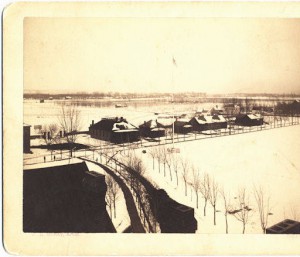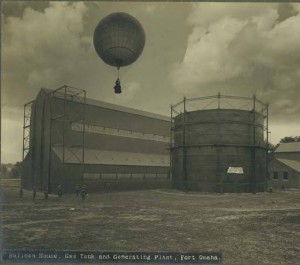
While I was in Rochester, New York this past Christmas visiting my husband’s family, my father-in-law showed me some letters from a World War I 2nd Lieutenant from Spencerport, NY, who had a Nebraska connection. Based on the letters and some further research, I found out that this young man was stationed at Fort Omaha, Nebraska for Balloon School.
Fort Omaha (the
Nebraska Memories picture to the left), located at 5730 North 30th Street, in Omaha, Nebraska, was opened in 1868 as an Indian War-era United States Army supply depot for various forts along the Platte River. This is also where Ponca Chief Standing Bear and 29 fellow Ponca were held prior to the landmark 1879 trial of
Standing Bear v. Crook. Judge Elmer Dundy determined that American Indians were persons within the meaning of the law and that the Ponca were illegally detained after leaving Indian Territory in January 1879.

The
Nebraska Memories picture of the fort to the right, was taken about that same time period.
Fort Omaha today is primarily occupied by Metropolitan Community College, but continues to house Navy, Marine and Army Reserve units. The fort is located in the present-day Miller Park neighborhood of North Omaha. The Fort Omaha Historic District is listed on the National Register of Historic Places. The district includes the 1879 General Crook House Museum, as well as the 1879 Quartermaster’s office, 1878 commissary, 1884 guardhouse, 1883 ordnance magazine and 1887 mule stables.
In 1907 the Army built a large steel hangar at Fort Omaha for use in experiments with dirigibles, a program that was abandoned in 1909. This program and its successor, the military use of hot air balloons for reconnaissance missions, were part of the American Expeditionary Forces. A balloon house was built in 1908, and in 1909 the first balloon flight took place. Here is a picture from
Nebraska Memories of the Balloon House at Fort Omaha, taken sometime between 1908 and 1910:

Shortly after the United States entered World War I, 800 men enlisted in the Aviation Section, U.S. Signal Corp, one of whom was William Spencer Barker, from Spencerport, NY. They were immediately sent to the Balloon School at Fort Omaha for training. More than 16,000 airmen went through the Balloon Schools at Fort Omaha and other locations around the U.S., between 1908 and the close of the program in 1919.
Balloonists were trained in map reading and charting troop movements. This information was communicated through an extensive switchboard system to artillery troops on the ground. The balloons were “captive” stationary balloons, utilized tail fins for stabilization, and had cables to tether the balloon to the ground.
In 1917, 2nd Lieutenant Baker was part of the 5th Squadron, Balloon Division, and did see military action with balloon squadrons in France from 1918-1919.
Visit
Nebraska Memories to search for or browse through many more historical images of digitized from photographs, negatives, postcards, maps, lantern slides, books and other materials.
Nebraska Memories is a cooperative project to digitize Nebraska-related historical and cultural heritage materials and make them available to researchers of all ages via the Internet. Nebraska Memories is brought to you by the Nebraska Library Commission. If your institution is interested in participating in Nebraska Memories, see
http://nlc.nebraska.gov/nebraskamemories/participation.aspx for more information, or contact
Beth Goble, Historical Services Librarian, or
Devra Dragos, Technology & Access Services Director.
 While I was in Rochester, New York this past Christmas visiting my husband’s family, my father-in-law showed me some letters from a World War I 2nd Lieutenant from Spencerport, NY, who had a Nebraska connection. Based on the letters and some further research, I found out that this young man was stationed at Fort Omaha, Nebraska for Balloon School.
Fort Omaha (the Nebraska Memories picture to the left), located at 5730 North 30th Street, in Omaha, Nebraska, was opened in 1868 as an Indian War-era United States Army supply depot for various forts along the Platte River. This is also where Ponca Chief Standing Bear and 29 fellow Ponca were held prior to the landmark 1879 trial of Standing Bear v. Crook. Judge Elmer Dundy determined that American Indians were persons within the meaning of the law and that the Ponca were illegally detained after leaving Indian Territory in January 1879.
While I was in Rochester, New York this past Christmas visiting my husband’s family, my father-in-law showed me some letters from a World War I 2nd Lieutenant from Spencerport, NY, who had a Nebraska connection. Based on the letters and some further research, I found out that this young man was stationed at Fort Omaha, Nebraska for Balloon School.
Fort Omaha (the Nebraska Memories picture to the left), located at 5730 North 30th Street, in Omaha, Nebraska, was opened in 1868 as an Indian War-era United States Army supply depot for various forts along the Platte River. This is also where Ponca Chief Standing Bear and 29 fellow Ponca were held prior to the landmark 1879 trial of Standing Bear v. Crook. Judge Elmer Dundy determined that American Indians were persons within the meaning of the law and that the Ponca were illegally detained after leaving Indian Territory in January 1879.  The Nebraska Memories picture of the fort to the right, was taken about that same time period.
Fort Omaha today is primarily occupied by Metropolitan Community College, but continues to house Navy, Marine and Army Reserve units. The fort is located in the present-day Miller Park neighborhood of North Omaha. The Fort Omaha Historic District is listed on the National Register of Historic Places. The district includes the 1879 General Crook House Museum, as well as the 1879 Quartermaster’s office, 1878 commissary, 1884 guardhouse, 1883 ordnance magazine and 1887 mule stables.
In 1907 the Army built a large steel hangar at Fort Omaha for use in experiments with dirigibles, a program that was abandoned in 1909. This program and its successor, the military use of hot air balloons for reconnaissance missions, were part of the American Expeditionary Forces. A balloon house was built in 1908, and in 1909 the first balloon flight took place. Here is a picture from Nebraska Memories of the Balloon House at Fort Omaha, taken sometime between 1908 and 1910:
The Nebraska Memories picture of the fort to the right, was taken about that same time period.
Fort Omaha today is primarily occupied by Metropolitan Community College, but continues to house Navy, Marine and Army Reserve units. The fort is located in the present-day Miller Park neighborhood of North Omaha. The Fort Omaha Historic District is listed on the National Register of Historic Places. The district includes the 1879 General Crook House Museum, as well as the 1879 Quartermaster’s office, 1878 commissary, 1884 guardhouse, 1883 ordnance magazine and 1887 mule stables.
In 1907 the Army built a large steel hangar at Fort Omaha for use in experiments with dirigibles, a program that was abandoned in 1909. This program and its successor, the military use of hot air balloons for reconnaissance missions, were part of the American Expeditionary Forces. A balloon house was built in 1908, and in 1909 the first balloon flight took place. Here is a picture from Nebraska Memories of the Balloon House at Fort Omaha, taken sometime between 1908 and 1910:
 Shortly after the United States entered World War I, 800 men enlisted in the Aviation Section, U.S. Signal Corp, one of whom was William Spencer Barker, from Spencerport, NY. They were immediately sent to the Balloon School at Fort Omaha for training. More than 16,000 airmen went through the Balloon Schools at Fort Omaha and other locations around the U.S., between 1908 and the close of the program in 1919.
Balloonists were trained in map reading and charting troop movements. This information was communicated through an extensive switchboard system to artillery troops on the ground. The balloons were “captive” stationary balloons, utilized tail fins for stabilization, and had cables to tether the balloon to the ground.
In 1917, 2nd Lieutenant Baker was part of the 5th Squadron, Balloon Division, and did see military action with balloon squadrons in France from 1918-1919.
Visit Nebraska Memories to search for or browse through many more historical images of digitized from photographs, negatives, postcards, maps, lantern slides, books and other materials.
Nebraska Memories is a cooperative project to digitize Nebraska-related historical and cultural heritage materials and make them available to researchers of all ages via the Internet. Nebraska Memories is brought to you by the Nebraska Library Commission. If your institution is interested in participating in Nebraska Memories, see http://nlc.nebraska.gov/nebraskamemories/participation.aspx for more information, or contact Beth Goble, Historical Services Librarian, or Devra Dragos, Technology & Access Services Director.
Shortly after the United States entered World War I, 800 men enlisted in the Aviation Section, U.S. Signal Corp, one of whom was William Spencer Barker, from Spencerport, NY. They were immediately sent to the Balloon School at Fort Omaha for training. More than 16,000 airmen went through the Balloon Schools at Fort Omaha and other locations around the U.S., between 1908 and the close of the program in 1919.
Balloonists were trained in map reading and charting troop movements. This information was communicated through an extensive switchboard system to artillery troops on the ground. The balloons were “captive” stationary balloons, utilized tail fins for stabilization, and had cables to tether the balloon to the ground.
In 1917, 2nd Lieutenant Baker was part of the 5th Squadron, Balloon Division, and did see military action with balloon squadrons in France from 1918-1919.
Visit Nebraska Memories to search for or browse through many more historical images of digitized from photographs, negatives, postcards, maps, lantern slides, books and other materials.
Nebraska Memories is a cooperative project to digitize Nebraska-related historical and cultural heritage materials and make them available to researchers of all ages via the Internet. Nebraska Memories is brought to you by the Nebraska Library Commission. If your institution is interested in participating in Nebraska Memories, see http://nlc.nebraska.gov/nebraskamemories/participation.aspx for more information, or contact Beth Goble, Historical Services Librarian, or Devra Dragos, Technology & Access Services Director.


My Grandpa. Elery Peterson was stationed at Ft. Dodge in the early 20th century. He was a baloonist, spotter for the Army. He never saw action in Europe. My Uncle John Peterson gave a presentation at the museum a number of years ago.
You wouldn’t have a copy of that presentation?
Let me know.
Thanks
Peter Thompson, Grandson
We do not have a copy of your uncle’s presentation, but you might check with the following: Douglas County Historical Society https://www.douglascohistory.org/ and The Durham Museum https://durhammuseum.org/